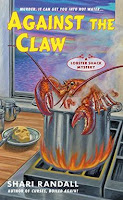Good morning and best wishes for a happy Memorial Day!
Hopefully, you can enjoy this day with some good reading. I'm going to recommend that you consider some offerings from my blogging partners here at The Stiletto Gang.
If you haven't already begun Shari Randall's Curses, Boiled Again!, check it out. It features injured ballerina Allie Larkin who is assisting her Aunt Gully with a lobster roll competition on Memorial Day when the judges are poisoned. Allie is spunky and delightful. The action is fast paced and the food descriptions will make you hungry!
Two of our blogging partners are celebrating Anthony nominations.The Anthony Awards, named for Anthony Boucher,
are presented each year at Bouchercon, and recognize excellence for novels, short fiction, nonfiction, and online presence. Congratulations to Dru Ann Love for her nomination for Dru's Book Musings and to Debra H. Goldstein for her short story nomination.
Because the Anthonys have nominations for both individual and collected
short stories, they introduce readers to a variety of wonderful short fiction. Following are this year’s nominees, who will be celebrated in
St. Petersburg, Florida, this fall:
BEST SHORT STORY
·
The Trial of Madame
Pelletier by Susanna Calkins from Malice Domestic 12: Mystery Most
Historical [Wildside Press]
·
God’s Gonna Cut You
Down by Jen Conley from Just to Watch Them Die: Crime Fiction Inspired by the
Songs of Johnny Cash [Gutter Books LLC]
·
My Side of the Matter
by Hilary Davidson from Killing Malmon [Down & Out Books]
·
Whose Wine Is It
Anyway by Barb Goffman from 50 Shades of Cabernet [Koehler Books]
·
The Night They Burned
Ms. Dixie’s Place by Debra H. Goldstein from Alfred Hitchcock’s Mystery
Magazine, May/June 2017 [Dell]
·
A Necessary Ingredient
by Art Taylor from Coast to Coast: Private Eyes from Sea to Shining
Sea [Down & Out Books]
BEST ANTHOLOGY
·
Just to Watch Them
Die: Crime Fiction Inspired by the Songs of Johnny Cash, Joe Clifford,
editor [Gutter Books LLC]
·
Killing Malmon, Dan
& Kate Malmon, editors [Down & Out Books]
·
Coast to Coast:
Private Eyes from Sea to Shining Sea, Andrew McAleer & Paul D. Marks,
editors [Down & Out Books]
·
Passport to Murder,
Bouchercon Anthology 2017, John McFetridge, editor [Down & Out Books]
·
The Obama Inheritance:
Fifteen Stories of Conspiracy Noir, Gary Phillips, editor [Three Rooms
Press]
Read and enjoy!





















